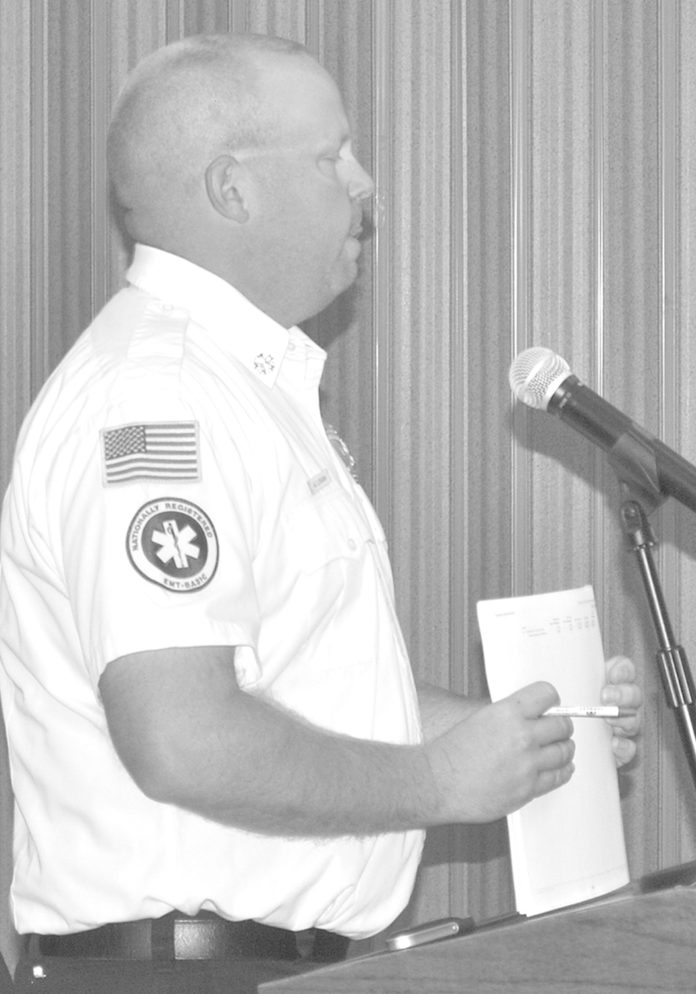By Mindy Ragan Wood, Staff Writer – EMSA is providing inadequate emergency medical services to Piedmont, Fire Chief Andy Logan told the city council Monday.
During an informational presentation, Logan reported the response times from EMSA to Piedmont citizens in crisis. The response times are based on a monthly report that EMSA provides and showed the average arrival time for an EMSA truck is 20 minutes. From the time a 911 call is placed to the time someone is transported to a medical facility, the time is 60 minutes on average, Logan said.
“Our current issues are very simple, it’s response times,” he said. “Twenty minutes is the average, I know some of you have heard longer, some of you have experienced longer. Our current longest is 54 minutes.”
Piedmont is in an inter-local agreement with EMSA and does not provide any guarantees to Piedmont “whatsoever,” he said. “There is no requirement from EMSA other than sending an ambulance to Piedmont. No time constraints, no service standards, nothing.”
Response requirement for calls are based on two categories. On priority one calls, the response time requirement is 11 minutes, and 25 minutes for priority two calls. Logan said EMSA claims it is in their contract that response time requirements are waived per the agreement, but he disputed that.
“I have been asking for six months, I’ve talked to Mr. Segler, I’ve talked to their legal team and they cannot produce it. It’s there, but in my opinion they are in breach of contract.
There’s some legalese there that I don’t understand. They said they don’t have to meet these times at all. I say they do.”
Logan reported that out of 107 priority one calls, EMSA was late to 79 of them. For priority two calls they were late 27 times.
“I looked at the numbers and they’re late 49 percent of the time by their standards, they’re late,” he said. “Seventy-nine out of 107 they’re late. That is shocking.”
The cost of the contract is $64,816 per year.
Logan said the council has some options to consider which include renegotiating the contract with EMSA, contracting with another third-party provider like Samaritan EMS, or add EMS transport services to Piedmont fire operations.
EMSA services are expected to increase. Other communities like Yukon have discontinued their services with EMSA and use Samaritan EMS.
“If we make no changes, we do not foresee response times improving at all. We do expect our subsidy to actually increase. EMSA recently lost Yukon and more recently lost Warr Acres and Bethany. They’re going to have to make up that money somewhere. They were turned down in Tulsa for a price increase. Our subsidy is going to go up,” Logan speculated.
“We expect to pay more with no improved service.”
Having an EMSA ambulance parked in Piedmont, though not every day, would cost the city $374,000 per year. Samaritan EMS would charge $264,000.
Logan presented a plan to include EMS services within the city’s fire department. He reported their own response time is four minutes and 30 seconds, would decrease the 911 call time to a medical facility by “at least half,” and stated the community could grow by offering the service in-house.
“I’ve talked to assisted living CEO’s and they tell me there’s no ambulance services out there for us,” he said.
The presentation included a 3D layout of where two EMS vehicles would be stored, one to have on call at all times and one as a backup in the event of maintenance or being on a call elsewhere.
Logan also pointed out the fire department would have to be expanded to accommodate sleeping quarters for the increased EMS staff. There is no bay space to house additional emergency vehicles. The estimated cost would be $360,000. Two ambulances would cost approximately $300,000 or $150,000 each. Startup costs for supplies, licensing, hiring a medical director, and staff equipment would cost approximately $36,500.
Logan suggested funding options to pay for the project such as capital improvement funds, a loan, or bond issue. Recurring operational costs could total $320,000 but could be offset with a $6 utility fee, $60,000 in billing revenue, $164,062 in municipal revenue, and regaining the $64,816 currently paid to EMSA. He suggested the entire project could be done in three phases over a period of two to three years.
Councilman John Brown said EMSA’s service was clearly substandard.
“I don’t feel that EMSA is providing the best possible service,” he said. “I think what EMSA is doing to us is terrible. Making no changes is not an option. We have to make changes.”
Brown agreed that EMSA would likely increase the subsidy cost to at least $75,000 because
“EMSA is in trouble. The director just resigned on embezzlement issues, over $1 million. There’s a good possibility EMSA may cease to exist.”
Brown recommended the city adopt their own EMS program within the fire department.
“Let’s allow our fire department, which is one of the best fire department for small towns in the state, let them do their job,” he said.
“We’ve all been talking about ambulance services for the last couple of years. It’s time, to ‘fish or cut bait’ as they say,” Mayor Valarie Thomerson said.
Councilman Bobby Williams asked if Logan was considering donors.
“We’re looking in every nook and cranny for any type of funding assistance,” he replied.
There was no formal vote on the issue.






